A local lady heard through the grapevine that I liked to tinker with old typewriters. K. had purchased a Royal KMM at a yard sale and was hoping to get it typing. I was glad to take on the project since it would be a distraction from my Twitter horror scrolling and my hand-wringing over the broken state of the world. She brought it over a couple weekends ago, and here it is on my porch on arrival:

1948 Royal KMM, serial number KMM-3577225
It was a rough, broken thing: twisted, rusty, dirty, and frozen. Everything on the left side of the machine was bent and compressed: carriage return, paper bail, spool cup, line spacing mechanism.
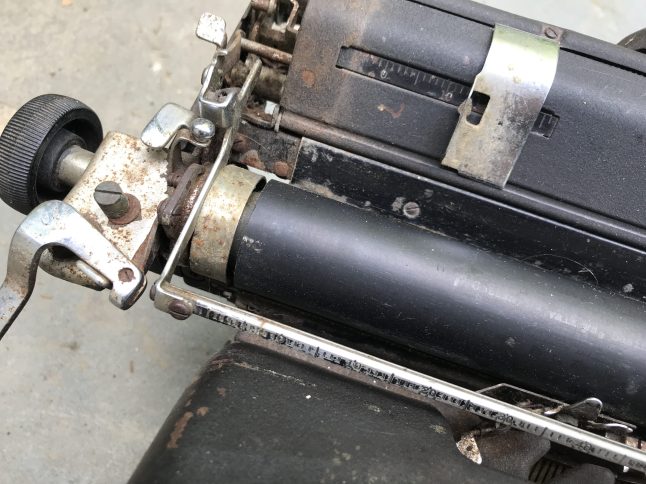
Paper bail jammed in there
It was so dirty. Just my type.
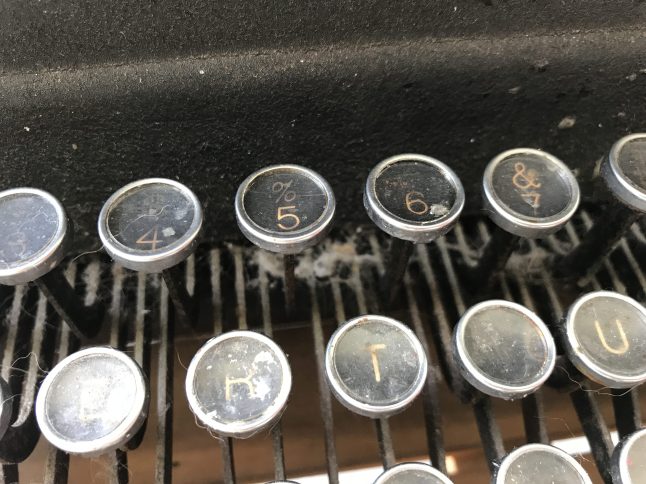
I told K. that I would do my best, but the typewriter was severely traumatized. Privately I thought to myself, these things are built like tanks, and it should be OK. KMMs are so solid. I think David McCullough is still typing books on his KMM. We had one growing up, and my mom typed the family cookbook on our KMM:

Midcentury recipes are a window into a mysterious time.
Some people wouldn’t touch a typewriter like this: too broken, too rusty, too messed up. To them, it’s a doorstop, a boat anchor, a parts machine. Me, I like them. I feel a moral obligation to fix these things.
After K. left, I wiped everything down with a dilute bleach solution (this is a pandemic after all). I took off the ribbon cover (nice explanatory video from Duane at Phoenix Typewriter). I then brought it out back and blew out the leaves and fur and greasy chunks with my air compressor.
I pried the paper bail out of the platen and straightened it using my patented Lady Gorilla™ maneuver. Carefully I straightened the carriage return arm, the crushed ribbon spool cup, and the line spacing mechanism. Once I got the carriage return lever clearing the ribbon spools, I set about cleaning the segment with mineral spirits. Things began to loosen up and the KMM began to exhibit its legendary sprightliness. The type guide had rusty burrs that caught the type so I did a little sanding.

The Magic Margins were not behaving themselves. They are sensitive to dirt and congealed grease, so I carefully cleaned the Magic Margin mechanism. The left margin improved with cleaning but the right was sliding all over the place and not catching. On examination, I found the margin stop’s ears bent and it was failing to engage in the teeth of the margin rack.

Bent margin stop
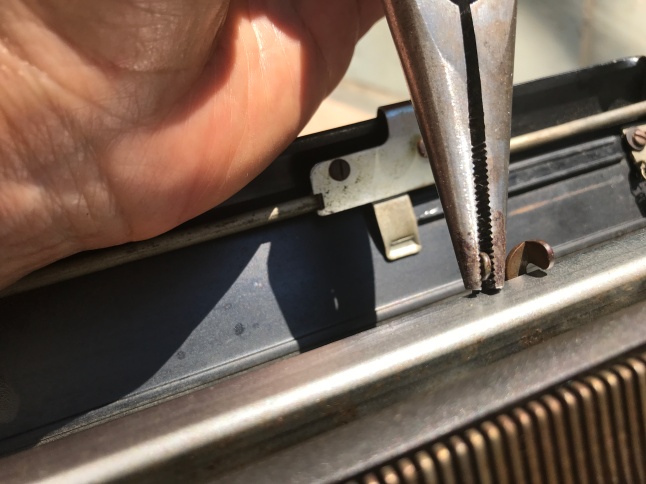
All better. Now I could set margins and they would hold. Now is the time for my annual rant about Magic Margins: they are not intuitive, notoriously finicky, and I don’t like them.
I began to address the last few bothersome issues. The typewriter was missing screws here and there, and things were a bit loose.

Missing platen set screw
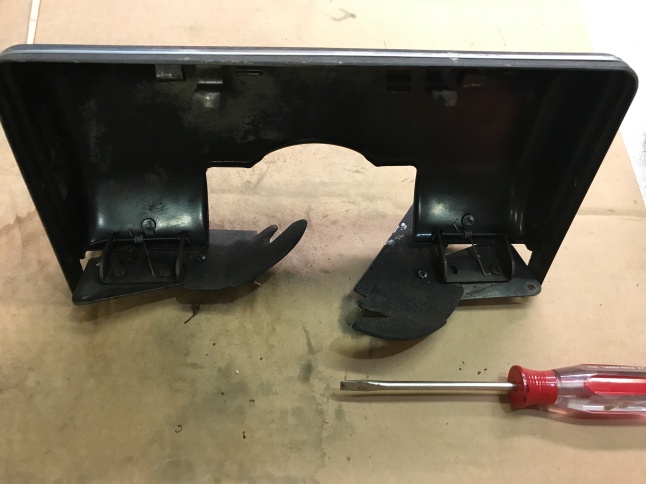
Wobbly ribbon cover
I know just the place to get the proper machine screws:
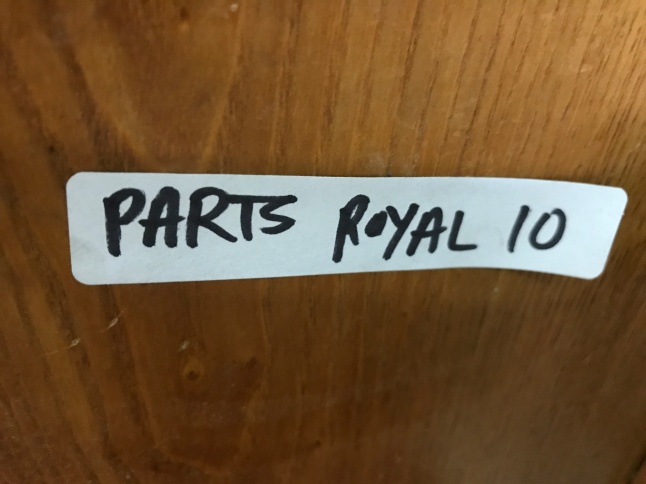
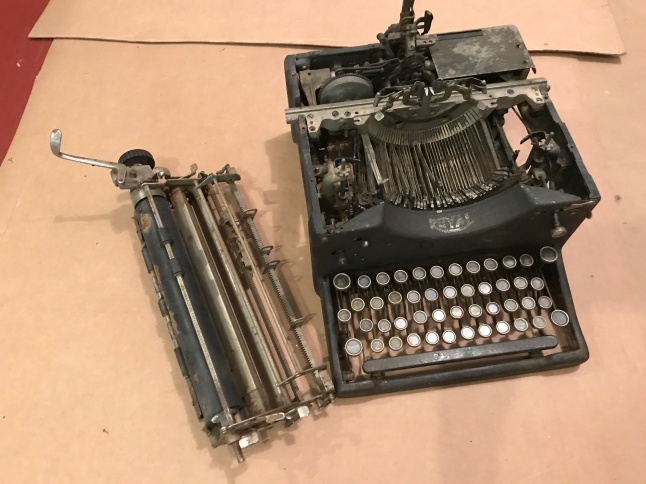
Thank you, Old Friend. You have given life to three other Royal 10s and now you help this KMM.
The shift was a bit low, so I made some adjustments (again, Duane from Phoenix Typewriter has a good video).
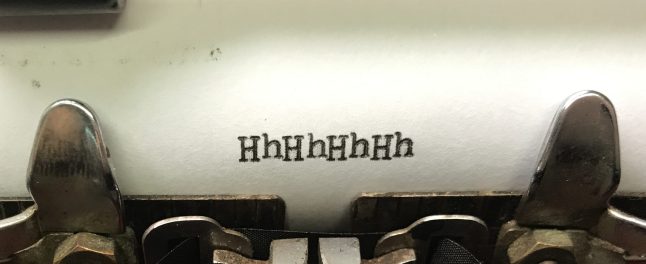
Good enough:

After a scrub down, I touched up the paint with some matte chalk paint I had on hand from a craft project and covered my repairs with some thick matte polyurethane for durability, brush stippling for texture. Not perfect, but looks a lot better.
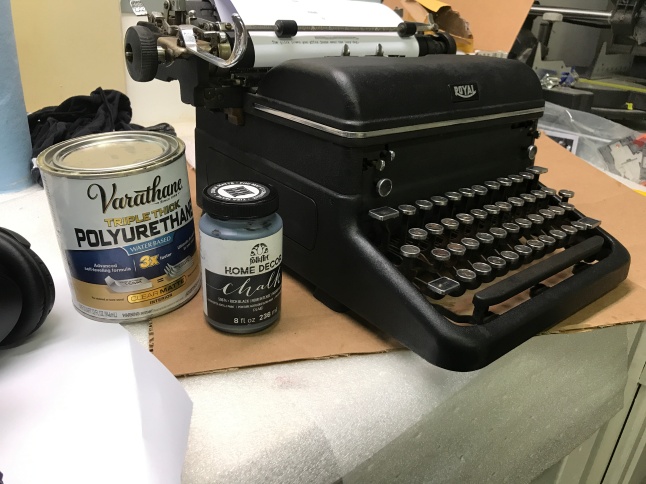
The last item that was bothering me was the faded keyboard legend. I am not a touch typist, and I was having problems testing since I need to know which keys I am striking.
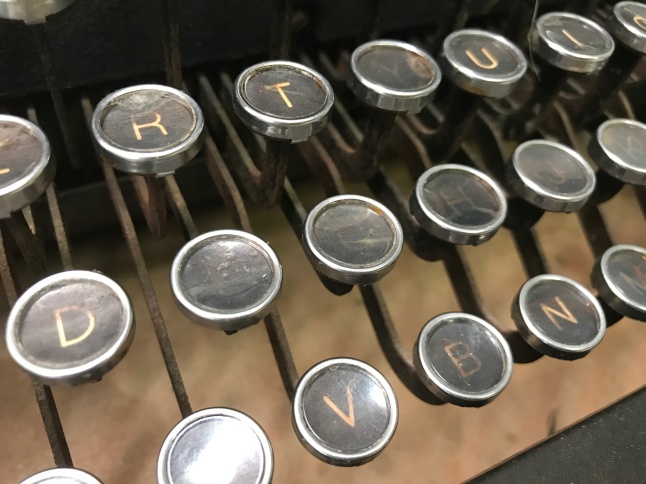
Richard Polt has a Royal key legend .pdf on his website which I could print out, but I wanted weathered, vintage replacements, and I had just the thing. About a year ago, a kind lady at Herman’s gave me a box of Royal keys with nice, clear legends on them.

The tricky part is that I do not own key ring removal and replacement tools which easily remove and replace the key rings. I am thinking about trading one of the kids for a set of those tools.
I used a pair of needle nose pliers to unbend each of the three key ring tabs that grasp the key top. Then I carefully held the stem with pliers from the bottom while gently, gently twisted off the ring with pliers from the top.
One down and a bunch more to go.

I was perking along, happily replacing key tops when I managed to twist the letter “W” key top all the way off. I was horrified, but grew philosophical. I knew that I could get good results re-attaching the key top with J-B Weld epoxy and a little platform fashioned out of scrap metal.
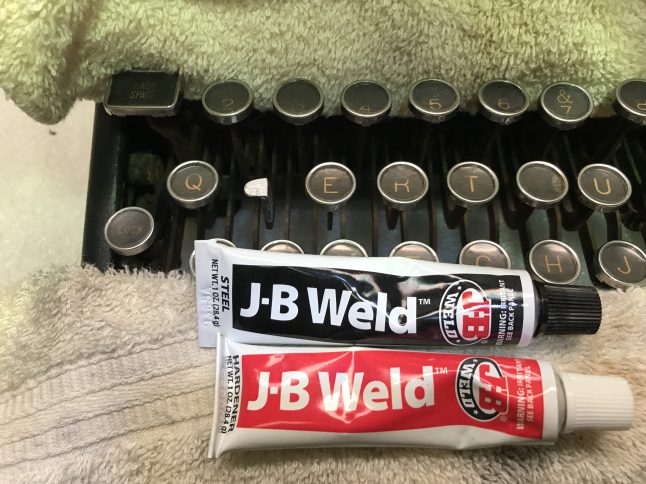
Time to put this KMM through its paces. Let’s fire up this old gal.

Blug. That new ribbon I ordered is very gloopy, and it looks like I need to clean the type a bit more.
Working on this banged up KMM gave me ample time to think my thoughts and ponder current and past events. Here’s the loose change that rattled around in the dryer:

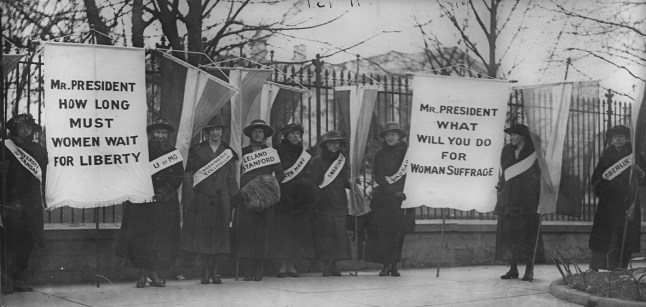
Picketing in front of the White House in 1917. Photo – Library of Congress Washington, D.C.
Read more about the “Silent Sentinels”.
Disruptive and disquieting, broad-based protests are incredibly powerful instruments of persuasion and change. Power’s reaction to protest is sometimes a damning tell, exposing loose rot propping up “institutions” we take for granted. Like the women’s suffrage movement, Black Lives Matter is using protest to present evidence of broken systems and to demand change.

There’s no easy fix, but there’s an opportunity and an obligation here to do better.

A stunning turn around of a good old trooper of a machine. I especially like how the chalk paint turned out. Nice work and thanks for detailing the journey. It also sounds therapeutic.
I saw David McCoullough’s machine at Cambridge Typewriter when it was in this past winter and it truly is beat up visually. I think we’re all feeling quite beat up metaphorically at the moment. I just got lost this week writing about Emily Dickinson’s garden. Getting lost in writing, mapmaking, and remembering was a tonic.
LikeLike
Wow! You saw the famous McCullough KMM! I read somewhere (I think Reddit) that he’s preparing to use it for his next book.
LikeLike
Bravo!
LikeLike
Really nice and informative, as usual!
LikeLike
I have been feeling a similar urge or moral obligation to fix what I can and where I can. Small things. This year I’ve gotten an antique clock repaired and an ancient sewing machine brought back to working order. Satisfying to fix things that I can (when the world around seems broken).
LikeLike
Great work on the KMM!
LikeLike
Beautimus! (:
You are brave to go after them rings without the tool (or even at all, without spares) – excellent work!
LikeLike
I won’t do it again without the tools – too risky. I think they’re brand-specific, so I’ll look for Royal set. Royal key legends always seem to be so faded.
LikeLike
All riiight! I have two KMM’s on my bench in various states of decrepitude. Your post may be the perfect inspiration to work on them this weekend. One came from a local antique mall and works about a C+. I decided I better buy it because someone had already mashed all the keys down, and I couldn’t! stand! that its dignity was already compromised in this way. I named it Jessica after scrutinizing the “Murder, She Wrote” opening and determining that Jessica Fletcher’s typewriter was a KMM. I too was inspired by David McCullough. A writer’s typewriter. The other was an impulse (cheap) buy from Goodwill of Iowa City, and boy is she rough, a D- at best. Filthy and nearly immobile. She shall be Jessica’s midwestern country cousin, name yet to be determined. Luckily key tops are good on both and I don’t think anything is missing. They both deserve better states of being, as do many of us. Opportunity and obligation, indeed.
LikeLike
You should have a good chance of possessing two fine typewriters after a good dusting and cleaning with mineral spirits. Scrub the segments and type, wipe down the carriage rails, give them some exercise, and they should come back to life.
LikeLike
Bravo, as usual. These KMMs are for me the quintessential “vintage-y” typewriter. There seem to be lots of them around (especially here — I live maybe a mile as the crow flies from the site of the factory), they look like a serious implement, and they’re well worth fixing up since they work well. The faded keytops are a drag, though, you’re right. But some seem to have aged better than others.
I will watch that video about the motion adjustment — I’ve tried doing this before and find it really a PITA.
Never knew chalk paint was a thing! But I won’t go to Hobby Lobby to get it.
LikeLike
The shift adjustment was a bit of a pain. I used a 7/16″ ignition wrench and a very small adjustable wrench.
I picked up the chalk paint some time ago at either JoAnn Fabric or Michael’s Crafts. It’s very opaque and completely flat in sheen – sticks to everything. I put a layer of matte polyurethane over the touch-ups as a protective clear coat.
LikeLike
We owned one of these wonderful old machines when I was a girl and I remember it fondly. Thank you for writing such a beautiful tribute to it, and to your grandmother.
LikeLike
Two legends. A KMM is a heckuva machine. My grandma was a heckuva gal. She taught high school shop class and coached her boys basketball team to a New Mexico state championship.
LikeLike
Hi there—just found a free typewriter and started doing research today. It seems to be a KMM in pretty great working order! I would like to get a new ribbon for it as this one seems dry and the letters are hardly visible on the paper. Do you know what kind of ribbon I should search for and where I can get it? Thank you for the cool post!
LikeLike
Hi Stacey, congratulations on your FREE typewriter – KMMs provide such a nice typing experience too!
Any 1/2″ typewriter ribbon will do. Hold onto the original metal spools – they are uniquely shaped for Royal standards and are expensive to replace and sometimes hard to find. When you get fresh ribbon, you’ll wind the new ribbon onto the original metal spools. Here’s a two pack at Amazon:
https://www.amazon.com/dp/B009JGXAHG/ref=cm_sw_em_r_mt_dp_B23HDQJAM38G78NXSK2V?_encoding=UTF8&psc=1
Hope this help!
LikeLike
Hi. From South Africa. Wonderful read. This weekend I obtained two typewriters. The owners had no use for it. Gold for me. One manual and electrical. Only problem I have is where can I get a ribbon for the manual and for the electrical one?
LikeLike
What make and model of typewriters were you given? Almost all manual typewriters use 1/2″ ribbon which can be found at most office supply stores. Simply re-spool the new ribbon onto the old spools. Here is an example of some ribbon that Amazon sells that works on old manual typewriters:
https://www.amazon.com/dp/B009JGXAHG/ref=cm_sw_em_r_mt_dp_K63FYW9X5EY3JMDD3JM6
Some electric typewriters use 1/2″ ribbon and some use a cassette-style ribbon. It depends on the make and model of the electric typewriter.
LikeLike
Hi — were you happy with how the “folk art home decor chalk paint rich black” turned out on this machine? I now have a KMM that really needs paint touch up and in the photos it looks like a perfect match — is that the case IRL? Still love your posts and your tutorials! THanks! – Chris
LikeLike
Thank you! I was very, very happy with the chalk paint I used. It was hanging around the house, left over from a craft project. I think any low-sheen black paint would have worked out though. On this particular machine, I had several areas of bare metal that I wanted to cover. I think that prep was important – de-greasing the shell with Simple Green or similar. Also, I *think* I used some primer on the bare metal since I wanted really good adhesion. I followed up the black chalk paint with thick matte polyurethane for durability, producing a sheen similar to the original. I stippled the paint and polyurethane to create a subtle texture. The typewriter looked really good IRL. It’s back with its owner now.
LikeLike
We made your mother’s cupcake recipe. It’s really good!
LikeLike
Oh, golly! I have never made that recipe since the ingredients seemed a little off-putting for cupcakes – that’s a failure of my imagination. So glad to hear that they actually tasted good.
LikeLike
It is an odd choice for cupcakes. We all agreed they taste like we should have made a bundt cake out of the batter instead. But the recipe would make for a really good bundt cake.
LikeLike
Once again, I’m just really glad that someone dusted off this recipe of my mother’s and tried it out.
LikeLike
Greetings. I’m struggling with a Smith Corona Secretarial standard from the 1950s. The margins are similar to Royal’s Magic Margin system, and my left hand margin won’t stay put. No matter where I set it, the blasted thing comes loose when typing. I’ve resorted to putting an alligator clip onto the rail, which holds it in place, but also disengages the margins completely. If you’ve worked with SC machines before I’d appreciate any help.
LikeLike
Hi Taylor! Those Royal Margin Margins and S-C Automatic Margin Levers can be so very finicky. The KMM that I wrote about had been dropped on its head, and the margin tabs were bent and not engaging with the teeth of the margin rack. You may have a similar problem. Or possibly a bent rack. Compare the way the margin mechanism grips the good right side with the way it grips the bad left side. There may be a subtle difference in the mechanism’s position. Right now I don’t have a Smith-Corona standard that I can investigate and take pictures of. You may want to post in the FB typewriter maintenance group. There are lots of friendly, helpful people there who may be able to snap some comparison photos for you of functional left margins. https://www.facebook.com/groups/typewritermaintenance/
LikeLike